Once you've seen two, a single won't do. Enjoy this selection of multiple deep-sky objects visible in the same field of view of your telescope.
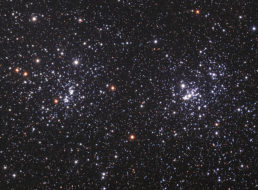
Hunter Wilson
BOGO is all the rage these days. Buy-One-Get-One free. Whether it's chips or cosmic wonders, count me in. I love when multiple deep-sky objects pair up in the same field of view. Many of us have scoped the well-beaten path to the Double Cluster in Perseus or the M81 / M82 galaxy pair. So-called "two-in-the-view" sights are among the first we show off to the public.
There are lots of duos and even some trios and tetrads out there. Recognizing the pleasure and challenge of seeing paired deep-sky objects, the Astronomical League offers a Two In The View observing program with a list of 114 objects. Observe at least 100 groupings on the list and you'll receive a certificate for your efforts.
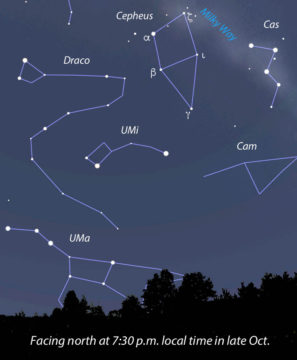
Stellarium
I thought it would be fun to apply the two-in-the-view idea to a single constellation and selected Cepheus as my target. It's high in the northern sky during early evening viewing hours and touched by the band of the Milky Way with a rich assortment of nebulae, star clusters, and galaxies.
I started out thinking I'd be observing duos, but deep-sky objects were so thick in places, 5 of the 10 selections became trios. I used a 15-inch telescope under rural Bortle Class 3 skies. All the featured objects fit within a 1° circle at my lowest magnification of 64×. North is up in all photos. In most cases, the two or three objects are unrelated and simply appear along similar lines of sight.
NGC 6939 and NGC 6946
There's no better place to begin than NGC 6946 and NGC 6939, a galaxy-cluster pair at the Cepheus–Cygnus border. NGC 6939 is an ancient open cluster more than 2 billion years old with about 300 members. At magnitude 7.8 it's a fine object in 6-inch and larger telescopes. I see an eye-catching dragonfly shape with a single, bright ~11-magnitude star at the west end of a starry "thorax" and "wings" extending north and south. You can't miss NGC 6946 40′ to the southeast. Fainter at magnitude 9.6, this 11.5′ × 9.8′ mottled puff of silky starlight has a broadly brighter core.
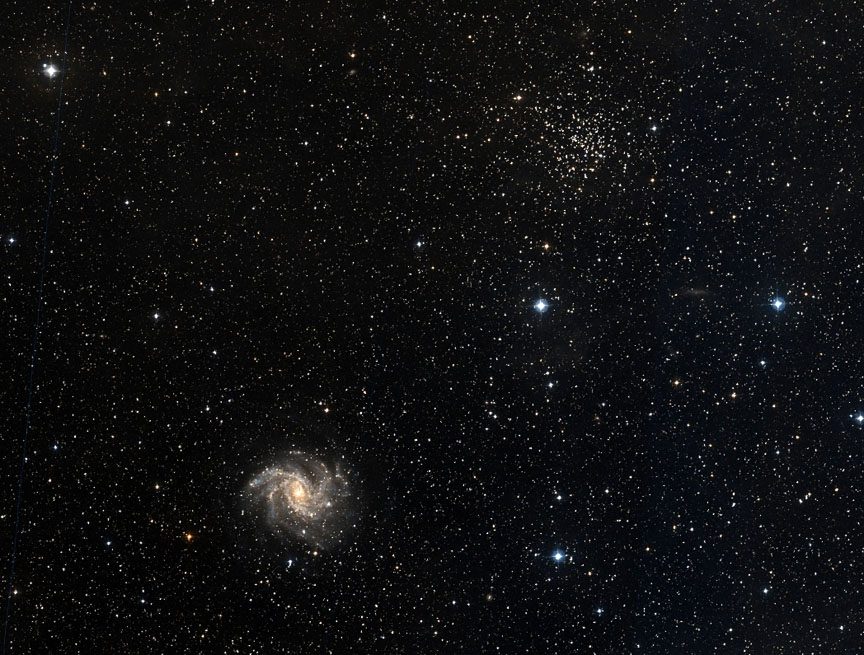
DSS2 / Aladin Star Atlas
Low magnification only hints at the flocculent spiral arms so prominent in photos. But if you turn up the power to 150× or more, magic happens. With averted vision at 142× I could discern three spiral arms. The longest and most prominent extends east of the core, a second to the north and a third — the most difficult — tucked in closer to the nucleus to the southwest.
Delta (δ) Cephei, NGC 7281, and NGC 7261 // Minkowski 2-51 and NGC 7235
This is a rich and rewarding region. All five objects lie within a 2.5°-wide patch of sky extending east and south of the famous variable Delta (δ) Cephei. Its variable fame often overshadows the fact that it's a bright and easy double star with a golden primary accompanied by a pale blue-white, 6th-magnitude companion 41″ to the southwest.
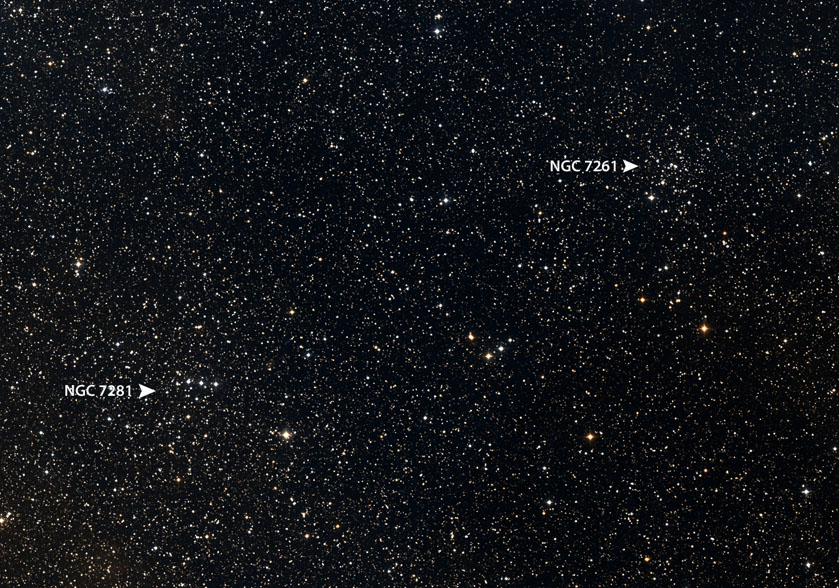
DSS2 / Aladin Star Atlas
About 45′ southwest of Delta you'll spy two modest open clusters also separated by 45′ — NGC 7281 and NGC 7261. Both fit comfortably within my 64× field of view. NGC 7281 contains about 20 stars tucked into a loose 12′-wide heap. Three 10th-magnitude stars form a striking east-west alignment that resembles Orion's Belt in miniature. NGC 7261 to the northwest is about 6′ across with a roughly triangular shape and a magnitude of 8.4. It's a little more compact that its companion and stands out well from the busy background star field.
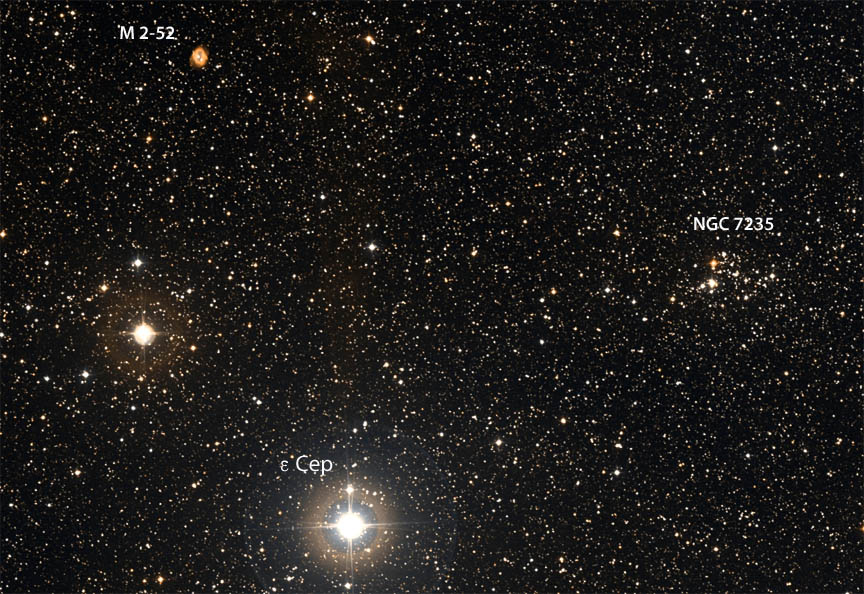
DSS2 / Aladin Star Atlas
And 45′ southwest of the cluster lurks one of my favorite duos, Minkowski 2-51, a relatively bright planetary nebula, and the tiny but gorgeous open cluster NGC 7235. I spotted the nebula, which measures 47″ × 38″, as a small, gray patch at 64× without the help of a nebular filter. Going to 142× I discerned a soft, round disk punctuated by two faint stars of magnitudes 14.5 and 15.5. Neither is the central star which glimmers at an impossible magnitude 20.4. Just 20′ southwest you can't miss NGC 7235, a pretty group of several dozen brighter stars shaped like a sideways letter Z that spans just 6′ with a total magnitude of 7.7. In their book Star Clusters, Archinal and Hynes list some 98 members for the cluster.
IC 1396, Trumpler 37, and Barnard 161 // Barnard 162 and Barnard 163
These five objects comprise a ridiculously rich mashup of emission nebulae, gloomy dust clouds, a huge open cluster, and a two stunning multiple stars that spill across 2° of sky. Arriving here, you'll first notice the open cluster Trumpler 37, which overfills the field of view at 1.5° across, with 50 member stars (it looks like many more), and a total magnitude of 3.5. The cluster is immersed in billows of faint emission nebulosity (IC 1396) dimly visible using an O III or UHC filter and low magnification. Together, they're make an overlapping two-for-one.
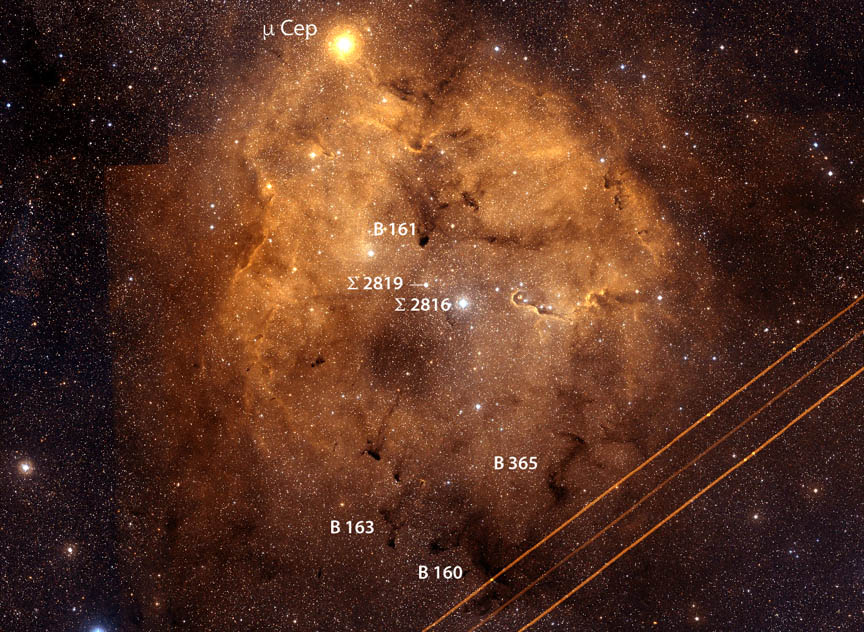
DSS2 / Aladin Star Atlas
Radiation from the massive and brilliant triple star Σ2816 at the nebula's center sets the surrounding gases aglow in the same way the Trapezium illuminates the Orion Nebula. Magnitude-5.7 Σ2816 is flanked on either side by two 7.5-magnitude stars at distances of 12″ and 20″. Just 12′ northeast you can't miss Σ2819, a beautiful double in its own right composed of a magnitude-7.5 star and a magnitude-8.5 star separated by 13″. Together, these dual stellar jewels are a must-see sight in any telescope.
Several dark nebulae nibble around the nebula's edges — B365, B160, B163 —while B161 "pokes" a small hole near the center. B160 is the most obvious to me with a mottled, dark texture and fat extension reaching to the east toward the lower contrast B163. Together these make a nice two-in-the-view dark nebulae pair separated by less than ½°. I also glimpsed B161 with averted vision as a small, starless area inside the nebula due north of Σ2819.
NGC 7510, King 19, and IC 1470 // Basel 3 and Sharpless 2-157
NGC 7510 always makes me smile. It looks like a two strands of geese winging southwest to warmer climes. This compact, rich cluster is a real standout, and you can't beat its unusual, elongated shape. Shining at magnitude 7.9, the groups hosts 75 birds, er stars, packed into a tight 7′ airspace. It's paired with King 19, a small, looser group of fainter stars 5′ across with a magnitude of 9.2. I counted from 15–20 stars but other sources give 50. I think these discrepancies arise because it can be difficult in rich fields to know where a cluster begins and ends as outliers can be mistaken for field stars.
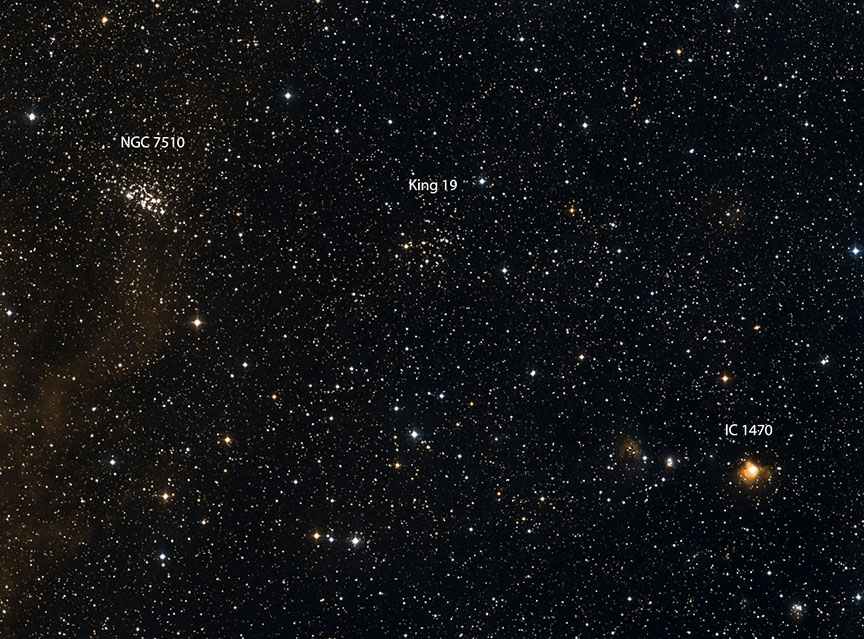
DSS2 / Aladin Star Atlas
The two clusters are joined by IC 1470, a small, bright and often overlooked emission nebula within the western edge of the 1° field. At first glance, it was just a minute blob of haze involved with an 11th-magnitude star, but when I increased the power to 142× I could see a comet lookalike with a brighter head centered on the star and a short, broad tail to the southwest. Emission nebulae are enhanced to varying degrees by nebular filters. Other observers report that a UHC filter works better on IC 1470 than an O III. I went black coffee and used neither.
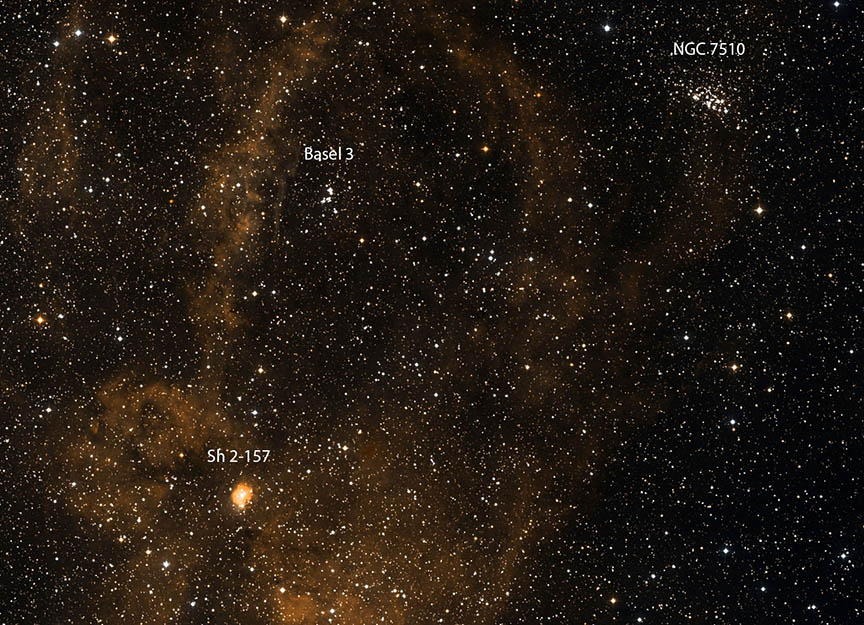
DSS2 / Aladin Star Atlas
A half-degree east of NGC 7510 you'll bump into another open cluster, Basel 3. Nothing fancy, just a small, loose group of a dozen ~11–12th-magnitude stars but nicely paired with another emission nebula, Sharpless 2-157, located just across the border in Cassiopeia. I saw a shapeless haze fuzzing up a 10th-magnitude star at 142×.
NGC 7380 / Sharpless 2-142, King 18, and Sharpless 2-148
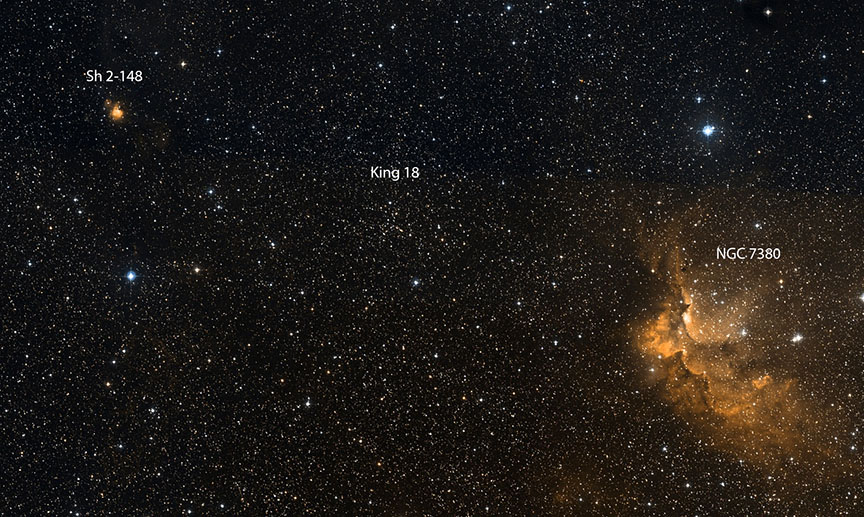
DSS2 / Aladan Star Atlas
It's so hard to pick a favorite star cluster. Just when you think you've got one, NGC 7380 comes along. Not only is it rich, with some 125 members, but the brightest ones form a Hyades-like outline, and the whole works is steeped in the emission nebula Sh 2-142, which shows up beautifully with an O III filter. Use low power for a great view, plus you'll see that the nebula (with a filter) extends faintly beyond the cluster to the southwest. NGC 7380 stands in fine contrast to the minimalist King 18 cluster 40′ to the east. I saw a 5′-wide bunch with about 20 stars that stands out well from the background. Keep moving east another 30′ and you'll come upon a gathering of small emission nebulae, each with its own Sharpless catalog number. I saw only Sh 2-148 as a small, but easy nebulous knot around a 13th-magnitude star.
NGC 7129, NGC 7133, and NGC 7142
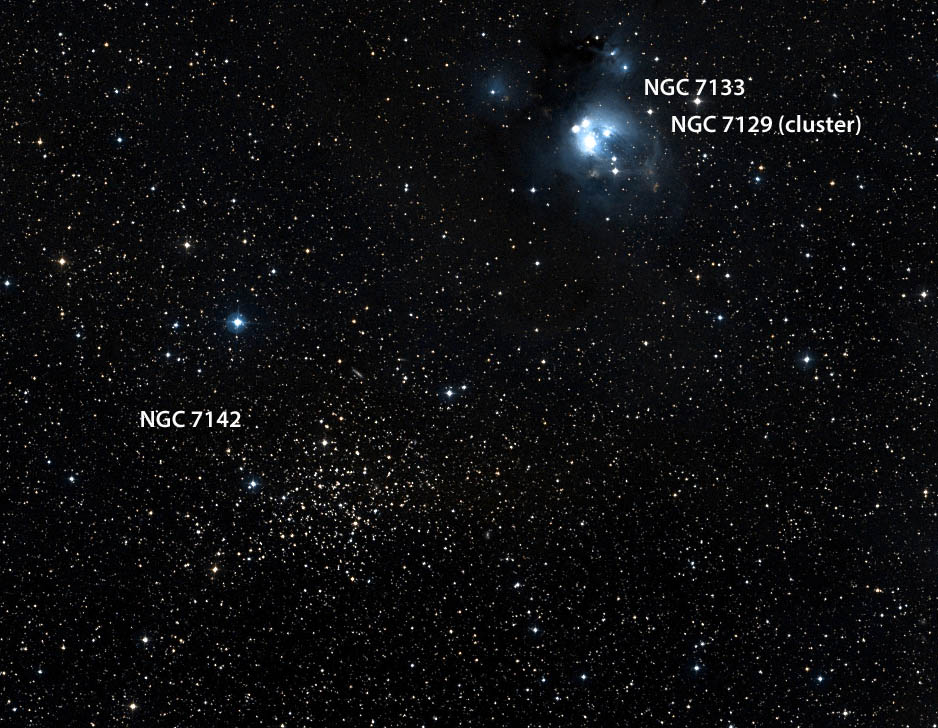
DSS2 / Aladin Star Atlas
NGC 7133 is a reflection nebula swaddling NGC 7129, a sparse but compact group of half-a-dozen bright 9th- and 10th-magnitude stars, all of it easily seen at a glance at low power. It's paired with the faint but incredibly rich open cluster NGC 7142 20′ to the southeast. I saw more than 100 stars here using 142×, many fainter than magnitude 12, giving the cluster a twinkly snowflake appearance. Absolutely beautiful! The combination of faint and rich with bright and sparse makes for a very appealing contrast, each helping to define the other.
NGC 7762 and Berkeley 59
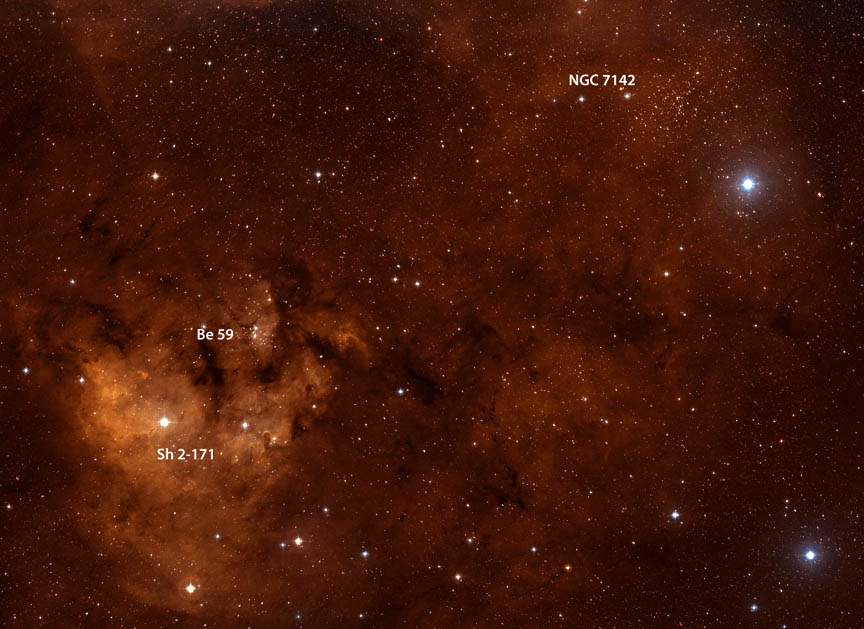
DSS2 / Aladin Sky Atlas
NGC 7762, a 10th-magnitude cluster, has a most interesting form, consisting of faint, rich strands of stars that look like the spreading filaments of a fiber optic lamp. What a contrast to its mate, Berkeley 59, a little over 1° to the southeast. Be59 is a dense gathering 10′ across with several 11th-magnitude stars in a tight knot at its core. There are 40 stars here in all with an estimated (my own) magnitude of 9.5. The cluster is a true baby, born less than a million years ago, and like the Trapezium, embedded in a large emission-reflection nebula, this one called Sharpless 2-171. Despite using filters, I couldn't be confident of seeing a trace of it.
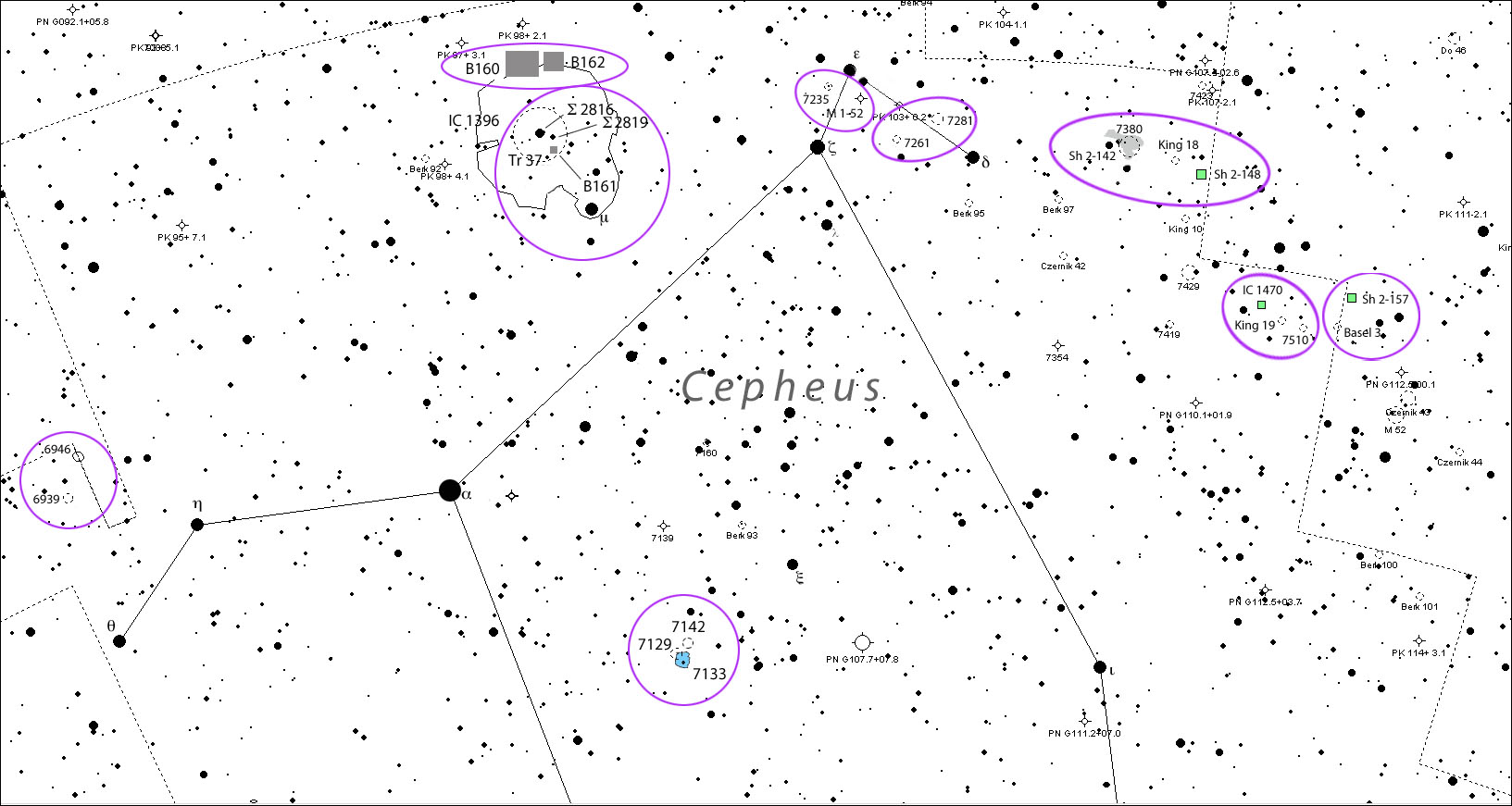
Chris Mariott's SkyMap with additions by the author
Although I used a 15-inch for my observations, many are visible in 8-inch telescopes and some in smaller instruments. As soon as the Moon departs the evening sky later this week, these dynamic duos — and trios! — await your gaze.
 11
11
Comments
Rod
October 24, 2018 at 2:50 pm
Bob, good report. You provided more NGC targets for me to chase 🙂 NGC 869 and NGC 884 are a wonderful double cluster in Perseus. The night of 12-Oct-18, I viewed these clusters using my 90-mm refactor and 10-inch Newtonian. Very good views, the 10-inch was much brighter image and more stars visible, especially with the 2-inch eyepiece. I plan to observe again once we approach Last Quarter Moon phase on 31-Oct-18. Nights where I live are much cooler now, temps in 30s and low 40s, mostly clear skies. No more pesky mosquitoes 🙂
You must be logged in to post a comment.
Bob KingPost Author
October 24, 2018 at 5:11 pm
Thanks, Rod. Isn't it great when the mosquitos are gone? October's usually my favorite month to observe before it gets too cold.
You must be logged in to post a comment.
Stephen-Carroll
October 25, 2018 at 10:19 am
Hi Bob,
I've really enjoyed your observing articles in the past (including this one). These articles are a nice compendium of things to observe and reasons you would want to do so - great for people who don't have a lot of time to plan this out for themselves. Do you have a compilation of these articles available somewhere?
You must be logged in to post a comment.
Bob KingPost Author
October 25, 2018 at 10:35 am
Thank you so much, Stephen. You can find all the articles if you go to skyandtelescope.com, look down the left side of the page to
"Explore the Night with Bob King" and click on the "More Posts ..." link. Happy observing!
You must be logged in to post a comment.
Stephen-Carroll
October 25, 2018 at 10:39 am
Yep, found them right after I posted my question. Anyway, they would make a great book...
You must be logged in to post a comment.
Bob KingPost Author
October 25, 2018 at 11:53 am
Stephen,
Thanks! Maybe some time in the future — you never know.
You must be logged in to post a comment.
Anthony Barreiro
October 25, 2018 at 3:07 pm
No time like the present! 🙂
You must be logged in to post a comment.
Bob KingPost Author
October 25, 2018 at 3:22 pm
Thanks for your support, Anthony!
You must be logged in to post a comment.
Tom-Reiland
October 26, 2018 at 4:20 pm
Another excellent article, Bob. I'm especially fond of the area around NGC 7510 and IC 1470. I usually start with M52, NGC 7538 and 7635 before I hop to that group. The cluster, Mrk 50, is to the east of 7510. Just South of !C 1470 is Reiland's Cluster that I discovered from my backyard in July of 1985 using my home-made 8" f/5 Newtonian. It shows up in the lower right corner of the image in your article. At first I thought it might be a comet, but at higher magnification I was able to resolve it into half a dozen stars. Walter Scott Houston wrote about it in his column in the Nov, 1988 issue of S & T and named it after me. The position is 23 hours 04 minutes 45 seconds, +60 deg 04 minutes 40 seconds. Here's a list of known Open Clusters that Dana Patchick sent me that includes Reiland 1: http://www.astro.iag.usp.br/ocdb/file/clusters.txt
You must be logged in to post a comment.
Bob KingPost Author
October 28, 2018 at 11:17 am
Thank you, Tom! And thanks for pointing out your cluster in the photo. I see it far down in the lower right hand corner and will put it on my list the next clear night. Do you know if it's a genuine cluster with the stars physically related? That's an amazing list of clusters by the way. I'm sure our readers will enjoy using it as an excellent reference and for coming up with observing targets of their own. Much appreciated.
You must be logged in to post a comment.
Tom-Reiland
October 28, 2018 at 2:51 pm
Your welcome, Bob. From what I've been told, it is a genuine cluster. There is faint nebulosity around it that was discovered by someone else. It is plotted in the Uranometria 2000, but under someone else's name who came across it in 1997, 12 years after I found it. The people at Willmann-Bell did not do proper research on it before they published it. Perry Remaklus admitted their error when I contacted him. He said they will correct in the next printing.
You must be logged in to post a comment.
You must be logged in to post a comment.